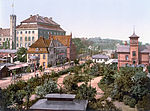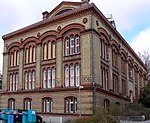Howaldtswerke-Deutsche Werft
1838 establishments in Schleswig-HolsteinCompanies based in KielCompanies established in 1838Defence companies of GermanyGerman corporate subsidiaries ... and 4 more
KielManufacturing companies established in 1838Military vehicle manufacturersShipbuilding companies of Germany

Howaldtswerke-Deutsche Werft (often abbreviated HDW) is a German shipbuilding company, headquartered in Kiel. It is part of the ThyssenKrupp Marine Systems (TKMS) group, owned by ThyssenKrupp. The Howaldtswerke shipyard was founded in Kiel in 1838 and merged with Hamburg-based Deutsche Werft to form Howaldtswerke-Deutsche Werft (HDW) in 1968. The company's shipyard was formerly used by Friedrich Krupp Germaniawerft until the end of World War II.
Excerpt from the Wikipedia article Howaldtswerke-Deutsche Werft (License: CC BY-SA 3.0, Authors, Images).Howaldtswerke-Deutsche Werft
Werftstraße, Kiel Ellerbek
Geographical coordinates (GPS) Address Nearby Places Show on map
Geographical coordinates (GPS)
| Latitude | Longitude |
|---|---|
| N 54.318888888889 ° | E 10.155555555556 ° |
Address
Werkfeuerwehr Thyssenkrupp Marine Systems
Werftstraße 112-114
24143 Kiel, Ellerbek
Schleswig-Holstein, Germany
Open on Google Maps










